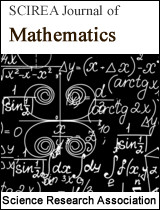The Validity of Generalized Modal SyllogismsBased on the SyllogismE□M◇O-1
DOI: 10.54647/mathematics110451 46 Downloads 227787 Views
Author(s)
Abstract
The simple and feasible methods for screening valid generalized modal syllogisms are as follows: (1) First, prove the validity of a generalized syllogism, then add at least one necessary modality (□) or possible modality (◇) to this syllogism, (2) Secondly, according to the basic fact that the conclusion of a modal syllogism is determined by the weakest premise, 12 valid generalized modal syllogisms in the same figure can be obtained by deleting invalid syllogisms; (3) Finally, taking each of these 12 syllogisms as a basic axiom, one can derive generalized modal syllogisms with different figures and forms by means of some definitions, facts, and deductive rules. This paper takes the generalized syllogisms with the general quantifier ‘most’ as an example to illustrate the above methods. The results obtained by this deductive method are logically consistent. This study not only has important theoretical value for us to deeply reveal the connections between/among things, but also has important practical significance for knowledge reasoning in artificial intelligence.
Keywords
generalized quantifiers; generalized syllogisms; generalized modal syllogisms; validity
Cite this paper
Liheng Hao,
The Validity of Generalized Modal SyllogismsBased on the SyllogismE□M◇O-1
, SCIREA Journal of Mathematics.
Volume 9, Issue 1, February 2024 | PP. 11-22.
10.54647/mathematics110451
References
| [ 1 ] | Chen, B. (2020). Introduction to Logic (4th Edition). Beijing: China Renmin University of Press, 2020. (in Chinese). |
| [ 2 ] | Chagrov, A., and Zakharyaschev, M. (1997). Modal Logic. Oxford: Clarendon Press. |
| [ 3 ] | Zhang, C. (2023). How to deduce the other 91 valid Aristotelian modal syllogisms from the syllogism □I□A□I-3. Applied Science and Innovative Research, 7(1), 46-57. |
| [ 4 ] | Halmos, P. R. (1974). Naive Set Theory. New York: Springer-Verlag. |
| [ 5 ] | Xu, J., and Zhang X. J. (2023a). How to obtain valid generalized modal syllogisms from valid generalized syllogisms, Applied Science and Innovative Research, 7(2), 45-51. |
| [ 6 ] | Xu, J., and Zhang X. J. (2023b). The reducibility of generalized modal syllogisms based on □AM◇I-1. SCIREA Journal of Philosophy, 3(1), 1-11. |
| [ 7 ] | Xu, J., and Zhang X. J. (2023c). How to obtain other valid generalized modal syllogisms from the syllogism □EF◇O-1. SCIREA Journal of Computer, 8(2), 63-73. |
| [ 8 ] | Johnson, F. (2004). Aristotle’s modal syllogisms, Handbook of the History of Logic, I, 247-338. |
| [ 9 ] | ?ukasiewicz, J. (1957). Aristotle’s Syllogistic: From the Standpoint of Modern Formal Logic(2nd Edition). Oxford: Clerndon Press. |
| [ 10 ] | Malink, M. (2013). Aristotle’s Modal Syllogistic. Cambridge: Harvard University Press. |
| [ 11 ] | Moss, L. S. (2008). Completeness theorems for syllogistic fragments. in F. Hamm and S. Kepser (eds.), Logics for Linguistic Structures, Berlin: Mouton de Gruyter, 143-173. |
| [ 12 ] | Peters, S. and Westerståhl, D. (2006). Quantifiers in Language and Logic. Oxford: Claredon Press. |
| [ 13 ] | Murinová, P. & Novák, V. (2012). A Formal Theory of Generalized Intermediate Syllogisms. Fuzzy Sets and Systems, 186, 47-80. |
| [ 14 ] | Hao, Y. J. (2023). The reductions between/among Aristotelian syllogisms based on the syllogism AII-3, SCIREA Journal of Philosophy, 3(1): 12-22. |

